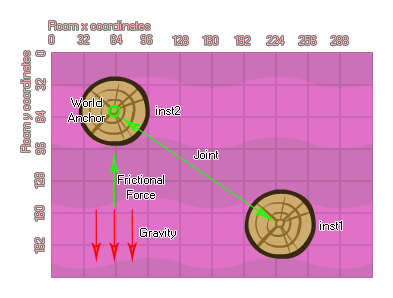
physics_joint_friction_create(inst1, inst2, anchor_x, anchor_y, max_force, max_torque, col)
| Argument | Description |
|---|---|
| inst1 | The first instance to connect with the joint |
| inst2 | The second instance to connect with the joint |
| anchor_x | The x coordinate for the joint, within the game world |
| anchor_y | The y coordinate for the joint, within the game world |
| max_force | The maximum frictional force that will be applied |
| max_torque | The maximum rotational force that will be applied |
| col | Whether the two instances can collide (true) or not (false) |
Returns: Index of the joint
The friction joint is a bit different to all other joints in the
physics simulation in that the connection created will not
constrain the instances position or movement, but rather its speed
and rotation. This works by taking the maximum input values for
force and torque and applying those to the second fixture to bring
the speed and angular momentum down to the same values as that of
the first instance. So, if you have a stationary instance and a
moving instance then connect them with a friction joint, the moving
instance will gradually slow down until it too is stationary. If
both instances were moving then the second instance will have its
movement speed modified to match that of the first instance.

As with most other joints, you supply the instances to join
together, as well as the position for the joint to be created at
within the room. You then supply the maximum force and maximum
torque (directional and rotational friction), and if you set the
"col" value to true then the two instances can interact
and collide with each other but only if they have collision
events, however if it is set to false, they will not
collide no matter what.
var mainFixture, o_id;
mainFixture = physics_fixture_create();
physics_fixture_set_circle_shape(mainFixture,
sprite_get_width(sprite_index) / 2);
o_id = instance_create(x+300, y, obj_Rudder);
physics_fixture_bind(mainFixture, id);
physics_fixture_bind(mainFixture, o_id);
physics_joint_friction_create(id, o_id, x, y, 10, 0.3, true);
physics_fixture_delete(mainFixture);
The above code will create a fixture then bind it to two instances, before connecting them both using a friction joint.